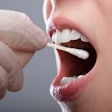
What is the best way to teach patients about oral health? The U.K.'s National Institute for Health and Care Excellence (NICE) recently released guidelines to help dental teams create effective patient-centered oral health promotions.
The guidelines, which were added to NICE's website in December, focus on how dental teams can best advise patients about oral hygiene, fluoride use, diet, smoking, tobacco, and alcohol. They were created based on the "best available evidence" and are put together by experts and stakeholders, like the public, according to the NICE website.
NICE breaks down the guidelines into two overarching categories:
- Oral health advice given by dentists and dental care professionals
- How dentists and dental care professionals can adopt a patient-centered approach
Giving oral health advice
The guidelines recommend that dental teams give all patients, or their guardians, evidence-based advice during their visit and tailor the advice to meet each individual's needs. This includes talking to every patient about the best oral hygiene practice and the importance of using fluoride. It also means talking to patients about diet, the drawbacks of smoking or using smokeless tobacco, and how alcohol intake can affect the mouth.
The guidance specifically mentions asking patients about their alcohol and tobacco use, as well as providing recommendations for smoking cessation or alcohol intervention services to those who may need it.
Adopting a patient-centered approach
When it comes to creating a patient-centered practice, the first key is to create a welcoming environment, according to the guidelines. They suggest that the whole dental team, including reception staff, work on developing relationships with all types of patients, including families with babies and those with physical or sensory impairment.
The guidelines also advise dental teams to withhold judgment of patients with poor oral health or whose behaviors may adversely affect their health. Instead, they recommend that teams take the time to develop a custom dental plan for each patient, asking about the following:
- Personal circumstances
- Oral hygiene practices
- Fluoride use
- Behaviors, including diet, smoking, or alcohol use, that can affect oral health
- Existing conditions or disabilities that may interfere with typical oral health recommendations
Finally, the guidelines recommend that dental teams remain aware of outside barriers to oral healthcare, such as environmental, economic, or social factors, and they suggest providing information for patients to see if they qualify for free or subsidized dental care.
Implementing the recommendations
The guidelines acknowledge that there may be some challenges when implementing these recommendations. That's why they recommend providing encouragement for teams to follow through with them.
"Commissioning and contracting arrangements that provide dental practices with appropriate incentives to maintain and improve people's oral health help dental teams to adopt a more preventive approach," the guidelines state.
The guidelines recommend that practices take the following steps:
- Compare their preventive performances with similar dental practices.
- Review case studies of practices with various successful business models that also provide preventive care
- Partner with other organizations and events to improve oral health throughout the community
While the NICE guidelines were created with U.K. dentists in mind, the recommendations are typically broad enough that dentists anywhere may be able to apply them.
To see the full guidelines, including the implementation strategy and tools and resources, visit the NICE website.



















